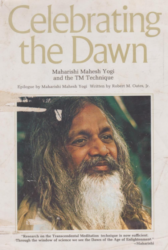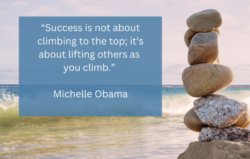Let’s Dance in the New Year (Part I)

I have mixed feelings about New Year’s resolutions. On the one hand, they’re a good excuse to set goals and get my life back on track. My resolutions tend to center on health, mainly because that’s a big focus in my life. But I can’t help but notice they’re all about changing things that are wrong with me. Like “I will stop eating sugar.” “I will lift weights three times a week.” “I will get to bed by 10.”
Each of these resolutions implies that I am lacking in some way—like I am currently eating way too much sugar, not building my muscles and not getting enough sleep.
I was thinking about how to make my resolutions stick, and a thought popped into my head: Perhaps these kinds of resolutions fail because they make us face the new year feeling less than inspired.
It occurred to me that maybe if they were a tad more positive and fun, I might actually stick to them. And who knows? They may have a better effect on my life than all the grimly disciplined “to dos” of my normal list.
This idea gained momentum for me when I read about Shonda Rhime’s new book Year of Yes: How to Dance It Out, Stand in the Sun, and Be Your Own Person.
If you’re like me and the name Shonda Rhimes doesn’t ring a bell, never mind—her accomplishments will. As the creator, head scriptwriter and executive producer of Grey’s Anatomy and other TV shows, and executive producer of How to Get Away with Murder, she calls herself a typical Type A personality. And until recently she was living a spectacular life on the job, but less so at home.
What spurred her to write the book, she says, was a sharp wake-up call from her sister. “You never say ‘yes’ to anything,” her sister said. This made Rhimes decide to not only say yes more often, but to seek out the very things she was prone to say ‘no’ to, the very things that scared her. And she ended up standing in the sun and dancing it out, as the book title shares.
I liked this idea of saying yes and immediately started making a list. Instead of focusing on things that scared me, I decided to focus on things that I want to continue doing because they are working for me. And on things I don’t allow myself to do because (as I tell myself), I don’t have time, don’t have money, don’t have the talent, etc.
Here’s my list so far:
1.) Taking a cue from Rhimes, I say yes to dancing. I’ve been taking a class in Indian classical dance that has been truly fun and has lots of health benefits too (when you slap your bare feet on the floor, all the nerve endings in your whole body wake up, stimulating your organs and hormones in a really good way). Plus it’s an all-women’s class, so that’s part of the fun. Yet lately, when I moved up to a more advanced class and couldn’t keep up with the practice time, I let it go. Yet in thinking it over, even if I practiced 10 short minutes a day, I could return to the class and not fall behind.
And why not say yes to this chance to dance? Why not twirl and swirl ten minutes a day? It’s worth a try.
2.) I say yes to taking time to engaging in unstructured play for an hour every week—to spending time in nature, wandering without a schedule, to journal or to play with my water colors and colored pencils.
Playing is so so so important, especially if you’re in a profession that relies on a fresh, creative mind. For me, playing not only rejuvenates my spirit but gives me new ideas that help me in my work. It’s a win-win, so why not say YES to play?
3.) I say yes to getting enough rest. Usually I feel tired by around 9:30 at night. I say yes to the needs of my body and mind. I say yes to paying them more attention. And I say yes to continuing to make time in my day for my twice daily practice of Transcendental Meditation. TM helps me feel happy. It helps me feel rested. It helps my mind think more clearly. And it keeps me grounded to my essential nature, so I stay connected to my best self even when the circumstances around me get challenging or crazy. So I say YES to giving myself this gift even if I’m traveling or with relatives or friends who don’t practice meditation.
4.) I say yes to continuing a great exercise routine. Full disclosure—I spent the money I received from my mom for Christmas on a Fitbit HR, and that has shown me that I’m doing well in the exercise realm. Taking a brisk 30-minute walk each morning with my husband in the early morning sunlight sets me up for the day—with just a little more exercise, my daily running around the apartment brings me to the recommended 10,000 steps most days without strain. And the three times a week weight training is making me feel so enlivened and happy. I say yes to continuing all that and more.
In writing these ideas down, in my mind saying yes started to converge with feeling gratitude for the things that are going right in my life. In some ways, I realized, gratitude is a way to find the yes in every experience.
And that is a good thing. I sometimes find myself—when I get stressed or have too many deadlines—wishing my computer didn’t take so long to boot up, that I didn’t have to wait in line, that there weren’t so many mundane tasks to do in a day. If I’m really stressed, I start feeling agitated by other people’s lack of speed or efficiency. Or my own lack of whatever.
This is not something I’m proud of. It’s a way of wishing life—and myself and the people in my life—were different. And when you start doing that, you can’t enjoy the great people and things that are right in front of you.
So now, when I’m waiting in line at the post office or at the grocery store, I’m using the time to think of things and people I’m grateful for, including the clerk who is so graciously serving me at that very moment. I also am starting each day thinking of three things I’m happy about, and ending the day that way too.
In Part II of this post I’ll explore the power of gratitude, its influence on brain functioning, and the latest findings on the Transcendental Meditation technique and its impact on happiness and well-being.
Happy New Year!
Let’s Dance in the New Year (Part II)
Does Gratitude Work?
Expressing gratitude is certainly not a new idea (prayer is a form of gratitude, after all), and lots of people have written about the power of gratitude in recent years. What is new is the increasing evidence that positive emotions, such as gratitude, have a positive effect on brain functioning.
The brain produces an astonishing 100,000 chemical and hormonal reactions every second. These can have good or bad effects. For instance, when we are stressed, the stress hormone cortisol courses through our body, contributing to aging, insulin resistance, and high blood pressure. Conversely, other chemical messengers have a positive effect on our minds and bodies—and are released when we are feeling balanced and happy.
Our brain’s neuronal connections also respond to our experiences and our emotions. In fact, the more we experience positive things in our lives, the more we give our attention to happiness, the more our brain gets wired to default to happiness, and the easier it gets to perceive our world in a positive light.
As brain scientist Jill Bolte Taylor wrote in her gripping memoir, My Stroke of Insight, “Scientists are well aware that the brain has tremendous ability to change its connections based upon its incoming stimulation. This ‘plasticity’ of the brain underlies its ability to recover lost function.”
Basically, she explains, the neuronal pathways strengthen to reflect the stimulation the brain is receiving. If you make it a habit to think about positive things, in other words, your mind will tend to repeat those neuronal loops instead of the negative ones. It’s kind of like building a muscle—you use the same thought patterns in your brain enough, and those neuronal circuits get stronger and stronger.
A Dance Between Spontaneity and Intention
Yet there’s a problem here. Unless you’re genuinely feeling happy, it’s hard to keep up the positive thinking for very long. It works fine for a while, but if you get tired, or rushed, or stressed, then all good intentions fly out the window. Finding yourself in a negative thought loop, you may say or do things that you later regret.
And, let’s face it, trying to be positive can be a strain. If you’re not actually feeling so happy, plastering a smile on your face is not going to change your inner reality a whole lot (research does say that the act of moving the muscles on your face does lift mood a little). But ask anyone who is depressed how it feels to try to smile and be happy, and they will tell you it is a tremendous strain.
In fact, constantly monitoring your thoughts, forcing any kind of feeling (even positive ones) can divide your mind and add tension and strain to your life.
When you genuinely feel happy, on the other hand, then it’s so easy to respond in a positive way to everyone around you. Then your gratitude is a natural expression of happiness, a spontaneous result of feeling happy.
I think this word “spontaneous” is really important. It’s one of the things that attracted me to the Transcendental Meditation technique in the first place. I really liked the idea that you could spend time meditating for 20 minutes twice a day, diving deep into that reservoir of intelligence, energy and happiness inside you, and then when you’re outside of meditation, spontaneously act. I liked the idea that I didn’t have to try to remember to be happy or make a mood of being happy—the results would come naturally as a result of the experience of pure happiness in meditation, my teacher said.
And that’s pretty much what happened. As I found myself growing in happiness, I naturally started having a more positive viewpoint on my life and the people around me. Basically, it’s become my default mode to feel gratitude—and if I sometimes fall into an impatient mode, it’s not that hard to shift back.
This is a common experience among people who practice TM, I’ve found out. People often find that when they begin the practice, others ask them, “What’s different about you? You seem so happy!”
Rewiring the Brain for Happiness
And yes, there is research that supports this experience of greater happiness. For instance, people practicing the TM technique score higher on tests of well-being and happiness, and higher levels of neurotransmitters such as serotonin are measured in the brains of TM practitioners. Research has also shown a significant decrease in stress, anxiety and depression in TM practitioners.
Dr. Fred Travis, the brilliant neuroscientist who has studied the effect of meditation on the neuroplasticity of the brain, explains that the experience of transcendence and inner happiness during Transcendental Meditation actually rewires the brain in a lasting way.
In his book, Your Brain is a River, Not a Rock, he explains that 70 percent of brain connections change every single day, a phenomenon called neuroplasticity.
“The circuits in the brain are continuously sculpted by experience,” he says. “If we are constantly under stress, then the part of the brain that triggers the fight-or-flight response grows thicker, and we find ourselves reacting to small stresses as if they are life-threatening.”
Dr. Travis goes on to say, “But—and this is the take-home point—if we add the experience of transcending to our daily routine, then brain connections that support the experience of pure consciousness are strengthened. This is the reality of growth to enlightenment. It happens every day with every session of the Transcendental Meditation technique.”
In other words, because in our quiet moments of meditation our minds experience the field of pure happiness inside us, that style of functioning of the brain becomes more dominant. Over time as we meditate regularly and go about our daily activities, the mind becomes more and more habituated to staying in that state of pure happiness, or bliss, even outside of meditation.
I love this idea of spontaneously growing in the ability to embrace more of life, of saying yes to the beautiful world around us. This is really what enlightenment is—experiencing everyone and everything as being as dear to us as our own self—our senses expanding to drink in the sounds, tastes, smells, textures and sights of our beautiful world. And from there, to embrace with love all our fellow creatures on this earth—whether family, friend or stranger across the world.
These are a few of my thoughts for the New Year—what are yours?
About the Author
Linda Egenes writes about green and healthy living and is the author of six books, including The Ramayana: A New Retelling of Valmiki’s Ancient Epic—Complete and Comprehensive, co-authored with Kumuda Reddy, M.D.
More Posts by Linda
- Tired and Burned Out? Transcendental Meditation Can Help: An Interview with Dr. Nancy Lonsdorf, MD
- Worried About the Future? Six Ways to Calm Your Anxiety
- What Do You Carry in Your Self-Care Tool Kit?
- Five Strategies for Family Caregivers
- From the Streets to College in Four Months: The Communiversity of South Africa Empowers Underserved Youth in Cape Town





